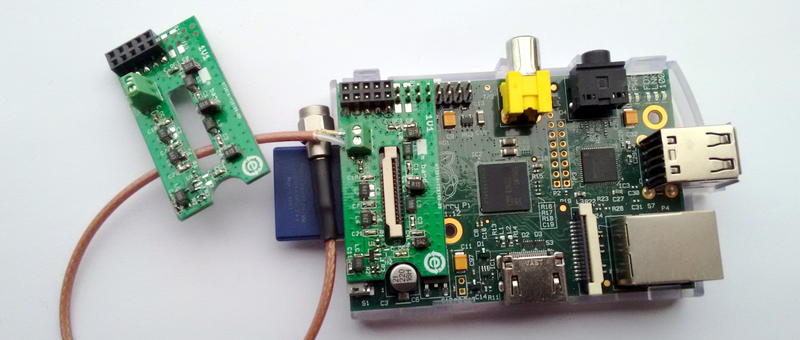Among its many tricks, the Raspberry Pi is capable of putting clock signals signal out on its GPIO pins, and that turns out to be just the thing for synthesizing RF signals in the amateur radio bands. What [Zoltan] realized, though, is that the resulting signals are pretty dirty, so he came up with a clever Pi shield for RF signal conditioning that turns a Pi into a quality low-power transmitter.
[Zoltan] stuffed a bandpass filter for broadband noise, a low-pass filter for harmonics, and a power amplifier to beef up the signal a bit into a tiny shield that is cleverly engineered to fit any version of the Pi. Even with the power amplifier, the resulting transmitter is still squarely in the realm of QRP, and the shield is optimized for use as a WSPR beacon on the 20-meter band. But there’s plenty of Pi software available to let hams try other modes, including CW, FM, SSB, and even SSTV, and other signal conditioning hardware for different bands.
Yes, these are commercially available products, but even if you’re not in the market for a shield like this, or if you want to roll your own, there’s a lot to learn from [Zoltan]’s presentation at the 2015 TAPR Digital Communications Conference (long video below). He discusses the difficulties encountered getting a low-profile shield to be compatible with every version of the Pi, and the design constraints that led to the decision to use SMT components.
















Inspirational! Kudos to Zoltan!
WSPR rules!
Im kind of surprised they used a 2 pin terminal block for the output instead of something like a SMB or SMC.
I was thinking the same. And all the “high-quality RF signals” are gone.
20m band is ~15MHz. This is although technically “radio frequency” not a really high frequency. A quarter wavelength is 5m, much much more than the dimensions of this clamp. Look at typical AM radios, they normally don’t have coaxial connectors for the antenna. The SMA connector is just total overkill for these frequencies.
In the video he says it’s too expensive.
I tend to use SMA connectors for just about anything in prototyping (even in few cases as purely mechanical fasteners) as I’ve always viewed them as cheap and mostly universal signal connectors.
Really? You can get 5 for $9 with free shipping off ebay.
Yeah that’s too much. Should be like 10 öre or something like that each.
It would be cool if this hardware was open source, like the software they use to make it run.
It IS open source, the project page has a link to a pdf file with full schematic and parts list.
https://www.tapr.org/pdf/DCC2015-QRPi-HA7DCD.pdf
“a clever Pi shield for RF signal conditioning”
The use of the word “shield” to mean “add-on daughterboard” is really unfortunate in this context. In the RF engineering world, a “shield” is a metallic enclosure that prevents signals from radiating outside it.
After reacting to the headline, thinking, “why does it need an RF enclosure? To keep the trashy digital emissions from raising the noise floor”, I get it now. It’s an add-on board.
Again, an unfortunate choice of words for daughterboards.
Indeed. Actually, “shields” in the “Raspberry Pi field” is called “HATs”
Could you generate IF with markers and add modulation for AM and FM aligning tuners?
i wandered in from a google news link. could someone tell me what the purpose of generating RF this way is? is it for testing home-built HAM equipment, or calibrating manufactured devices? thx for any feedback
To use as a transmitter on amateur radio bands.
In this particular case on the 20m (~14MHz) amateur band in the WSPR mode.
WSPR is basicly a low power automated propagation beacon mode used to study HF propagation.
Or in more practical terms, to find band openings in an easy way.
People also enjoy being heard on other continents with powerlevels like 20mW.
Live map of WSPR reception reports:
http://wsprnet.org/drupal/wsprnet/map
What WSPR is:
https://en.wikipedia.org/wiki/WSPR_(amateur_radio_software)
Interestingly WSPR seems to have been invented by K1JT a Nobellist and well known for his JT65 mode among other things.
thx much for reply. i used to play with am radio with a yaesu, never went for the license.. but hence my interest
“shields”, “hats” and “spiders”. All names given to devices that already have standard technology names, by experimenters who feel their precious is so groundbreaking that it needs a new name, even though it is the same old type of part. (“spider”, by the way, is the latest name for a “ground plane” antenna, in the realm of ADS-B hobbyists. They’ll tell you the “spider” was, until the advent of the RTL dongle, only used by “HAM” operators.[note capitalized ‘HAM’])